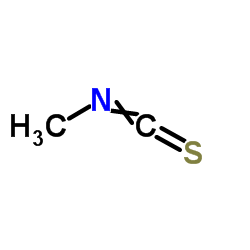Microbial aspects of accelerated degradation of metam sodium in soil.
Shachaf Triky-Dotan, Maya Ofek, Miriam Austerweil, Bracha Steiner, Dror Minz, Jaacov Katan, Abraham Gamliel
Index: Phytopathology 100(4) , 367-75, (2010)
Full Text: HTML
Abstract
Preplant soil fumigation with metam sodium is used worldwide to control soilborne diseases. The development of accelerated degradation of pesticides in soil, including metam sodium, results in reduced pesticide efficacy. Therefore, we studied microbial involvement in accelerated degradation of methyl isothiocyanate (MITC) following repeated soil applications of the parent compound, metam sodium. MITC degradation was reduced in soil with a history of metam sodium applications following sterilization, indicating the key role of microorganisms in accelerated degradation. Accelerated degradation of MITC was induced by inoculation of soil with no previous application of metam sodium with soil with a history of metam sodium applications. We developed a method to extract the active microbial fraction responsible for MITC degradation from soil with a history of metam sodium applications. This concentrated soil extract induced accelerated degradation of MITC when added to two different soils with no previous application of metam sodium. An extensive shift in total bacterial community composition in concentrated soil extracts occurred after a single metam sodium application. Two Oxalobacteraceae strains, MDB3 and MDB10, isolated from Rehovot soil following triple application of metam sodium rapidly degraded MITC in soil with no previous application of metam sodium. Polymerase chain reaction-denaturing gradient gel electrophoresis analysis of bacterial community composition showed relative enrichment of MDB3 following metam sodium application, suggesting its potential in situ involvement in accelerated degradation development in Rehovot soil. Responses of resident Oxalobacteraceae community members to metam sodium applications differed between Rehovot and En Tamar soils. Isolate MDB10 did not induce accelerated degradation of MITC in En Tamar soil and, with the slow dissipation of MITC, soil suppressiveness of accelerated degradation is suggested. The isolation and identification of MITC-degrading bacteria might be helpful in developing tools for managing accelerated degradation.
Related Compounds
| Structure | Name/CAS No. | Molecular Formula | Articles |
|---|---|---|---|
 |
Methyl isothiocyanate
CAS:556-61-6 |
C2H3NS |
|
Olfactometry Profiles and Quantitation of Volatile Sulfur Co...
2015-09-02 [J. Agric. Food Chem. 63 , 7511-21, (2015)] |
|
Human olfactory bulb neural stem cells mitigate movement dis...
2015-07-01 [J. Cell Physiol. 230(7) , 1614-29, (2015)] |
|
Absolute kinetics and reaction efficiencies of hydroxyl-radi...
2010-09-01 [Chemosphere 81(3) , 339-44, (2010)] |
|
The enantioseparation of amino acids on a teicoplanin chiral...
2006-08-01 [Biomed. Chromatogr. 20(8) , 718-28, (2006)] |
|
Metam sodium intoxication: the specific role of degradation ...
2011-06-01 [Clin. Toxicol. (Phila.) 49(5) , 416-22, (2011)] |